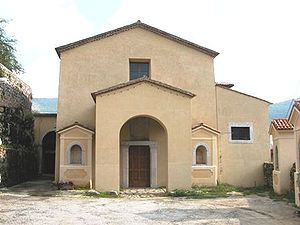- Ciociaria in cinematography
-
In Italian literature some folkloric words like Ciociaria and ciociari are used to denote both many people and locations of cinematography. Those terms pin some characters that has been often considered a part of Italian neorealism as well.[1]
Many writers say that they have found poetical inspiration in lands south of Rome thanks to a large variety of local traditions, ancient rural landscapes and people's provincialism. Those characters should belong to a geografical region between Tevere and Garigliano, where artists like Alberto Moravia, Elsa Morante, Cesare Zavattini, Cesare Pascarella, Pier Paolo Pasolini, Giuseppe De Santis, Vittorio De Sica lived, producing famous novels and movies.
In 1960 De Sica made a film "Two Women" in Vallecorsa, where he represented in cinematography Moravia's novel "La Ciociara"; for the first time the terms ciociari and Ciociaria appeared in Italian cinematography. After that some film makers of Italian neorealism who lived in southern Lazio called this land Ciociaria as well as the landscapes they represented in some movies. The term was taken both from ancient books of tourist voyages like Pascarella's Viaggio in Ciociaria and from some fascist historical searches about province of Frosinone and "ruralization". In this uncertain context De Santis considered Ciociaria in cinematography as a topos with which the oppressions of poor pleasants has been expressed in some Italian neorealistic films and he showed this point of view in his movie Non c'è pace tra gli ulivi explicitly.[2] Between Miracles is another movie in which Ciociaria is evoked, following a public statement of the author Nino Manfredi who says that the plot represents a part of his life during which he was conteporary rebel and repressed, just in Ciociaria, where he was born.[3]
In common language terms like Ciociaria and ciociari are used to denote both any movies set in southern Latium and many actors who was born in province of Frosinone or in province of Latina. Some people thinks the term ciociaro is an insult so they refuse to be called like that.[4]
Movies and locations
- La Ciociara (Vittorio De Sica - Fondi, province of Latina)
- The Incredible Army of Brancaleone (M. Monicelli - Jenne, sets in province of Rome)
- Bread, Love and Dreams (Luigi Comencini, where Gina Lollobrigida and Vittorio De Sica name "Forca d'Acero Wood", in Comino Valley).
- Gli onorevoli di Sergio Corbucci, Totò is Antonio La Trippa Roccasecca's syndi in Province of Frosinone.
- Between Miracles (Nino Manfredi, sets in Fontana Liri, Province of Frosinone).
- Straziami ma di baci saziami di Dino Risi (1966), Nino Manfredi is a barber of Alatri.
- San Pasquale Baylonne protettore delle donne (1976), sets in Settefrati and Posta Fibreno, province of Frosinone.
References
- ^ Vitti A., La Ciociaria nel cinema, in Zangrilli F., Bonaviri G., La Ciociaria tra letteratura e cinema, Metauro ed., Pesaro 2002, pp. 291-305
- ^ De Santis G., Letter to Adriano Baracco, in «Cinema», 15 november 1950, n. 50
- ^ Manfredi N., Nudo d'attore, Mondadori, Milano 1993, p. 9.
- ^ An Italian spot where Sofia Loren was called ciociara has been contested by some politicals of Lazio because they considered that term as offensive. (Italian) [1]
Sources
- Zangrilli F., Bonaviri G., La Ciociaria tra letteratura e cinema, Metauro ed., Pesaro 2002
- Pascarella C., Viaggio in Ciociaria, Roma 1920.
Cinema of Italy Actors · Directors · Animation · Cinematographers · Composers · Editors · Producers · Screenwriters  Films A-Z · Films by year: 1910 · 1911 · 1912 · 1913 · 1914 · 1915 · 1916 · 1917 · 1918 · 1919 · 1920 · 1921 · 1922 · 1923 · 1924 · 1925 · 1926 · 1927 · 1928 · 1929 · 1930 · 1931 · 1932 · 1933 · 1934 · 1935 · 1936 · 1937 · 1938 · 1939 · 1940 · 1941 · 1942 · 1943 · 1944 · 1945 · 1946 · 1947 · 1948 · 1949 · 1950 · 1951 · 1952 · 1953 · 1954 · 1955 · 1956 · 1957 · 1958 · 1959 · 1960 · 1961 · 1962 · 1963 · 1964 · 1965 · 1966 · 1967 · 1968 · 1969 · 1970 · 1971 · 1972 · 1973 · 1974 · 1975 · 1976 · 1977 · 1978 · 1979 · 1980 · 1981 · 1982 · 1983 · 1984 · 1985 · 1986 · 1987 · 1988 · 1989 · 1990 · 1991 · 1992 · 1993 · 1994 · 1995 · 1996 · 1997 · 1998 · 1999 · 2000 · 2001 · 2002 · 2003 · 2004 · 2005 · 2006 · 2007 · 2008 · 2009 · 2010 · 2011Categories:
Films A-Z · Films by year: 1910 · 1911 · 1912 · 1913 · 1914 · 1915 · 1916 · 1917 · 1918 · 1919 · 1920 · 1921 · 1922 · 1923 · 1924 · 1925 · 1926 · 1927 · 1928 · 1929 · 1930 · 1931 · 1932 · 1933 · 1934 · 1935 · 1936 · 1937 · 1938 · 1939 · 1940 · 1941 · 1942 · 1943 · 1944 · 1945 · 1946 · 1947 · 1948 · 1949 · 1950 · 1951 · 1952 · 1953 · 1954 · 1955 · 1956 · 1957 · 1958 · 1959 · 1960 · 1961 · 1962 · 1963 · 1964 · 1965 · 1966 · 1967 · 1968 · 1969 · 1970 · 1971 · 1972 · 1973 · 1974 · 1975 · 1976 · 1977 · 1978 · 1979 · 1980 · 1981 · 1982 · 1983 · 1984 · 1985 · 1986 · 1987 · 1988 · 1989 · 1990 · 1991 · 1992 · 1993 · 1994 · 1995 · 1996 · 1997 · 1998 · 1999 · 2000 · 2001 · 2002 · 2003 · 2004 · 2005 · 2006 · 2007 · 2008 · 2009 · 2010 · 2011Categories:
Wikimedia Foundation. 2010.

